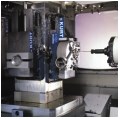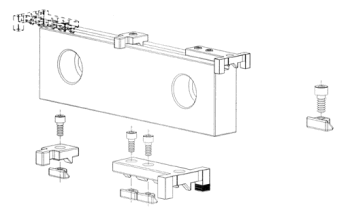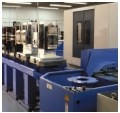Flexibility Is A Vise
The ubiquitous table vise is more than a fixture in metalworking shops. It's a necessity. Like the machine tools they attach to, metalworking vises have had their share of technical advances aimed at extending the flexibility of these popular workholders.
Share





Successful metalworking applications generally are the result of doing numerous small things well. It's an additive process that, when taken together as a whole, creates optimum throughput, good quality workpieces, repeatability, and ultimately a profit for the shop.
Workholding is one of the factors in the metalcutting equation. With good part programs on the right machine tool, sharp and balanced tools and correct coolant formulation, secure workholding will help lead to a successful application.
In many shops a primary means of workholding is the precision metalworking vise. Many shops don't give much thought to their vises; however, vise builders have been busy in recent years creating accessories, attachments and some clever ways to extend the flexibility and accuracy of these workholding workhorses.
To find out what's being done to extend the application range of the precision machine vise, we talked Ingo Wolfe, vice president of Kurt Manufacturing Company (Minneapolis, Minnesota). This company has been working diligently to increase the usefulness of more than half a million of their vises installed in metalworking shops around the world. Here's what they have to say.
Standard Versus Custom
An age-old battle within metalworking shops and manufacturing in general involves the drive for standardization or modularity as opposed to purpose-built or custom solutions. This debate includes most of the technologies used in the metalworking process.
Take machine tools for example. In many traditionally custom production lines, such as transfer line technology, the industry is moving to programmable machining center-type modules. A primary reason for this shift in technology is the need to be flexible.
Rather than dedicate an expensive, albeit efficient, machine line to a narrow group of parts, these new lines can handle entire families of parts. And, if the need arises, the flexible line can be re-applied to different workpieces rather than scrapped out.
The rise of general-purpose machine tools and the increasing use of automated cells in contract and job shop environments also speaks to this trend. Standardization in these cases relates to the use of palletization and common machine tool control technologies.
A standardized pallet is still one step removed from standardized workholding. It's the workholder that presents an application to the cutter, machine and coolant for processing. It's the workholder that must accommodate any asymmetrical geometric variations on the blank.
If all workpieces were symmetrical, workholding would be a snap. In the real world, workpieces come in all shapes and sizes. Because of these differences, workholding is an integral part of any machining process analysis.
"Even a workholder as seemingly basic as the precision machine vise has technology associated with it," says Mr. Wolfe. "The prime driver in shops today is to try to use basic modules that are designed to work together to extend standard workholding into the realm of custom fixtures—economically."
When to build part-specific workholding and when to use a standardized modular type of workholder such as a vise is a decision shops face every day. Kurt and other vise companies have extended the application range of the metalworking vise to make it a much more "customizable" workholder.
The Need For Speed
Securely holding a workpiece during machining operations necessitates hanging onto as much of the workpiece as possible. On the other hand, for the cutter to access as much of the part as possible, the operator wants to grip only what's necessary.
To accomplish both goals, there are a large number of different vise jaw configurations available. To make changing from one set of jaws to the next faster, vise manufacturers have created quick-change jaw sets.
While various manufacturers have different designs of quick-change vise jaws, all of them work to accomplish fundamentally the same task—expedite the changeover from one jaw set to another. This is usually done by simplifying the attachment method between the jaw set and the moving and non-moving permanent vise jaws.
In Kurt's case, its quick-change jaws slip over a pair of low head screws and are tightened using an allen wrench. The entire operation takes about five seconds.
Economical Custom Fixtures
In many shops, once the base of the vise is mounted to the machine and located, you don't want to move it. Here some advances in vise modularity can be very helpful in saving job changeover setup and tear-down time.
Machinable vise jaws represent one big step forward in modular workholding. With these blocks, a shop can machine a set of jaws that will grip and support irregularly shaped workpieces that would have otherwise required custom fixtures.
These machined jaws then attach to a machine-mounted vise base that acts as a receiver. Quick-change clamps between the jaws and vise body make changing these jaws as simple as any standard jaw set. In Kurt's design, repeatability for machinable jaws is ±0.001 inch.
Shops can chose from either cast iron or aluminum as the material for these jaws.
The standard block size is 6 inches by 6 inches by 1.728 inches high. They can be indexed so all sides of the block can be machined. Machinable jaws are an economical method of creating what is effectively a custom fixture for a fraction of the cost. Storage of these jaws is also simplified because only the modular jaws need be stored.
This modular design has the added advantage of accepting standard quick-change jaw sets for symmetrical workpiece applications. The vise body simply stays put on the machine tool.
Noodles—The Softer Side
A classic no-no in the machine shop is to try to clamp three workpieces in one vise. Almost without exception, one of the three parts will be loose or, at best, not be fully clamped. Bring a mill to cut, and more than likely one of the blanks goes flying.
There is a way to get around this and perform light duty clamping on three or more parts in a single vise. The idea is to create a grip with some give. Using a moving jaw with permeable inserts, the workpieces can be pressed against the stationary jaw of the vise. Small size differences between the blanks are compensated for with the inserts.
While this sounds simple, there is some technology that comes into play. "We call these inserts noodles," says Mr. Wolfe. "They are actually polyurethane rods that measure a quarter inch in diameter. To accommodate different workpiece materials, they are available in three different hardness grades."
In operation, the rods lie in four grooves milled in a quick-change vise jaw. The jaw mounts on the moveable permanent jaw on the vise. The polyurethane deforms when the jaw contacts the workpiece, pushing the work against the stationary jaw. The resilience of the polyurethane in effect pre-loads the work against the stationary jaw.
What's not intuitive with this device is the need to control how the polyurethane material flows after compressing against the workpiece. By milling the slots that hold the noodle with some extra space, the compressed polyurethane has a controllable path to flow into. Without the control, the noodle would try to push or lift the workpiece out of the vise.
This noodle is a simple solution to the soft grip problem. Many different workpiece sizes can be gripped using the noodle system as long as they fit the vise. It's also part of a modular system so the hard jaws and noodle jaws can be interchanged on the same vise base.
Rolling Stops
Workstops are as old as workholders themselves. On a vise or other workholder, the idea is to create a relatively foolproof method that encourages consistently accurate placement of the workpiece in the workholder. This is done with a stop.
Many shops build their own stops. They may be as simple as a bracket attached to the side of a vise. Some can be more elaborate. It depends on the job.
The down side of many homemade stops is that when the job is changed over, new or different stops are usually required for incoming jobs. Fabrication and attachment of the new stop become part of setup and as a result, add to the time required.
Kurt has developed a system that uses standard precision-machined stops that attach to a slot in a quick-change vise jaw. These stops are made with a very low profile to reduce interference with the machine tool cutter.
With the design of their workstop system, Kurt can place stops in virtually any location on the vise jaw to accommodate single or multiple workpieces. During machining the stops help guide the operator to correctly load blank workpieces in the vise.
When the run is over, the stop arrangement setup can remain attached to the vise jaw and simply be removed and stored for the next run. With a repeatability of 0.001 inch, these jaws can be reused on subsequent job runs with little or no additional alignment.
A Changing World
If one looks at the metalworking industry from a distance, one undeniable trend is apparent. Many of the biggest manufacturing companies are phasing out as much metalcutting part production as they can. Flexibility and quicker response to change are primary reasons these bigger companies are looking outside.
As a result, metalworking shops from coast to coast increasingly find themselves linked in a longer chain of suppliers that leads directly to OEM companies. It's imperative that these shops keep themselves flexible and able to "turn on a dime" when change is needed. They must also be efficient part producers.
A systematized approach to information gathering and evaluation of existing methods will help shops stay ahead. This includes occasionally looking at such shop staples as workholding vises.
Related Content
Prioritizing Workholding Density Versus Simplicity
Determining whether to use high-density fixtures or to simplify workholding requires a deeper look into the details of your parts and processes.
Read MoreCustom Workholding Principles to Live By
Workholding solutions can take on infinite forms and all would be correct to some degree. Follow these tips to help optimize custom workholding solutions.
Read MoreParts and Programs: Setup for Success
Tips for program and work setups that can simplify adjustments and troubleshooting.
Read MoreFixturing Castings Made Simple Through Adhesive Workholding
When a casting proved too malleable for traditional gripping, Thomas/Euclid Industries adopted — and succeeded with — Blue Photon adhesive workholding.
Read MoreRead Next
Registration Now Open for the Precision Machining Technology Show (PMTS) 2025
The precision machining industry’s premier event returns to Cleveland, OH, April 1-3.
Read More5 Rules of Thumb for Buying CNC Machine Tools
Use these tips to carefully plan your machine tool purchases and to avoid regretting your decision later.
Read MoreSetting Up the Building Blocks for a Digital Factory
Woodward Inc. spent over a year developing an API to connect machines to its digital factory. Caron Engineering’s MiConnect has cut most of this process while also granting the shop greater access to machine information.
Read More












.jpg;width=700;quality=80)


















.jpg;maxWidth=300;quality=90)








